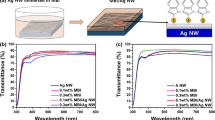Abstract
Thin-film structures based on gas-sensitive tungsten oxide Ag/WO x /W exhibiting a bipolar resistive switching effect were prepared. The current-voltage characteristics of the structures were studied in air with laboratory humidity and after hydrogen feeding into the chamber to a concentration of 2% in the air. The chemical state of the surface layers of the resulting structures was analyzed by X-ray photoelectron spectroscopy. The morphology and structural condition were studied by atomic force and scanning electron microscopy and micro-Raman spectroscopy. A severe reaction to hydrogen was found in the Ag/WO x /W structure subjected to additional heat treatment in the air at 200°C. The annealing of this structure gave rise to the formation of silver nanoparticles with an oxide coating on the surface of tungsten oxide. The formation of nano-particles resulted in a change in contact properties and offered hydrogen efficient access to the contact areas, as is evidenced by an increase in the flow of current in the low- and high-resistive states of this structure. A comparison of the reaction to hydrogen exhibited by WO x /W and Ag/WO x /W structures suggested that hydrogen had a significant effect on the mechanism of formation of conductive silver threads in the oxide layer and the chemical state of the interface owing to a change in the kinetics of the electrochemical oxidation-reduction processes in the contact areas of Ag/WO x . The results show the possibility of designing hydrogen sensors operating on new physical principles.
Similar content being viewed by others
References
T. Hubert, L. Boon-Brett, G. Black, and U. Banach, “Hydrogen sensors — a review,” Sensors Actuators B 157, 329–352 (2011).
M. T. Soo, K. Y. Cheong, and A. F. M. Noor, “Advances of SiC-based MOS capacitor hydrogen sensors for harsh environment applications,” Sensors Actuators B 151, 39–55 (2010).
A. Trinchi, S. Kandasamy, and W. Wlodarski, “High temperature field effect hydrogen and hydrocarbon gas sensors based on SiC MOS devices,” Sensors Actuators B 133, 705–716 (2008).
V. Yu. Fominskii, R. I. Romanov, V. V. Zuev, A. G. Gnedovets, and M. I. Alymov, “Functional micro- and nanostructure layers based on tungsten oxide for high temperature hydrogen detectors on Pt-oxide-SiC platform,” Ross. Nanotekhnol. 7(5–6), 32–37 (2012).
V. Yu. Fominskii, S. N. Grigor’ev, R. I. Romanov, V. V. Zuev, and V. V. Grigor’ev, “Properties of tungsten oxide thin film formed by ion-plasma and laser deposition for hydrogen detector based on MOSiC structure,” Fiz. Tekhn. Poluprovodn. 46(3), 416–424 (2012).
B. U. Jang, A. I. Inamdar, J. Kim, W. Jung, H. Im, H. Kim, and J. P. Hong, “Effects of oxygen stoichiometry on resistive switching properties in amorphous tungsten oxide films,” Thin Solid Films 520, 5451–5454 (2012).
C. Y. Dong, D. S. Shang, L. Shi, J. R. Sun, B. G. Shen, F. Zhuge, R. W. Li, and W. Chen, “Roles of silver oxide in the bipolar resistance switching devices with silver electrode,” Appl. Phys. Lett. 98, 072107 (2011).
D. S. Shang, L. Shi, J. R. Sun, B. G. Shen, F. Zhuge, R. W. Li, and Y. G. Zhao, “Improvement of reproducible resistance switching in polycrystalline tungsten oxide films by in situ oxygen annealing,” Appl. Phys. Lett. 96, 072103 (2010).
V. Yu. Fominskii, R. I. Romanov, A. G. Gnedovets, V. V. Zuev, and M. V. Demin, “How Energy parameters of deposited laser-initiated platinum atoms flow influences onto the characteristics of Pt/n-6H-SiC thin-film structure,” Fiz. Tekhn. Poluprovodn. 44(4), 556–563 (2010).
V. Yu. Fominskii, R. I. Romanov, V. N. Nevolin, and A. G. Gnedovets, “Formation features of metallic oxide thin-film layers that formed in gas-sensor structure Pt/WOx/SiC by pulse laser deposition method,” Perspekt. Mater., No. 2, 5–12 (2011).
L. H. Tjeng, M. B. J. Meinders, J. van Elp, J. Ghijsen, G. A. Sawatzky, and R. L. Johnson, “Electronic structure of Ag2O,” Phys. Rev. B 41, 3190–3199 (1990).
E. Cazzanelli, L. Papalino, A. Pennisi, and F. Simone, “Spatial variation of structural order in sputtered WO3 films,” Electrochim. Acta 46, 1937–1944 (2001).
A. Cremonesi, Y. Djaoued, D. Bersani, and P. P. Lottici, “Micro-Raman spectroscopy on polyethyleneglycol assisted sol-gel meso and macroporous WO3 thin films for electrochromic applications,” Thin Solid Films 516, 4128–4132 (2008).
V. Yu. Fominskii, R. I. Romanov, and V. E. Koshmanov, “The way to synthesize tungsten trioxide films for hydrogen detector on MOSiC platform,” Yad. Fiz. Inzh. 2(2), 166–170 (2011).
A. Al Mohammad and M. Gillet, “Phase transformations in WO3 thin films during annealing,” Thin Solid Films 408, 302–309 (2002).
G. I. N. Waterhouse, G. A. Bowmaker, and J. B. Metson, “Oxidation of a polycrystalline foil by reaction with ozone,” Appl. Surf. Sci. 183, 191–204 (2001).
Li Ying-Tao, Long Shi-Bing, Liu Qi, Lü Hang-Bing, Liu Su, and Liu Ming, “An overview of resistive random access memory devices,” Chinese Sci. Bull. 56(28–29), 3072–3078 (2011).
Li Ying-Tao, Long Shi-Bing, Lü Hang-Bing, Liu Qi, Wang Qin, Wang Yan, Zhang Sen, Lian Wen-Tai, Liu Su, and Liu Ming, “Investigation of resistive switching behaviours in WO3-based RRAM devices,” Chin. Phys. B 20(1), 017305 (2011).
P. K. Biju, Xinjun Liu, Seonghyun Kim, Manzar Siddik, Jungho Shin, Joonmyoung Lee, and Hyunsang Hwang, “Bipolar resistance switching in the Pt/WOx/W nonvolatile memory devices,” Current Appl. Phys. 11, e62–e65 (2011).
R. S. Crandall and B. W. Faughnan, “Electronic transport in amorphous HzWO3,” Phys. Rev. Lett. 39(4), 232–235 (1979).
Author information
Authors and Affiliations
Corresponding author
Additional information
Original Russian Text © R.I. Romanov, V.V. Zuev, V.Yu. Fominskii, A.G. Gnedovets, M.I. Alymov, 2013, published in Rossiiskie Nanotekhnologii, 2013, Vol. 8, Nos. 7–8.
Rights and permissions
About this article
Cite this article
Romanov, R.I., Zuev, V.V., Fominskii, V.Y. et al. Effect of hydrogen on the electrical properties of a Ag/WO x /W thin-film structure exhibiting resistive switching behavior. Nanotechnol Russia 8, 437–444 (2013). https://doi.org/10.1134/S1995078013040149
Received:
Accepted:
Published:
Issue Date:
DOI: https://doi.org/10.1134/S1995078013040149



